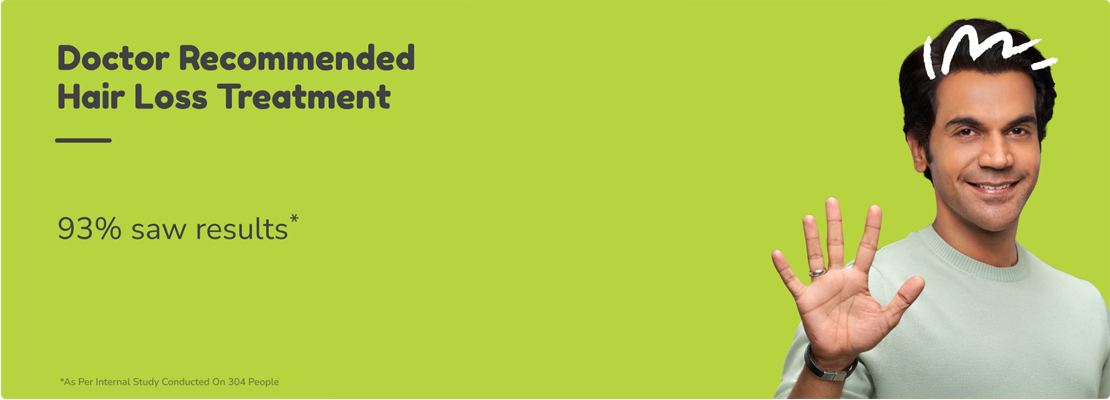Alopecia stands for hair loss in medical terminology. It could be the result of natural causes, of different diseases or the use of medications. It could also be genetic hair loss. The pattern of loss could be as varied as a bald patch on your scalp to loss of hair all over your body. Let’s find out about the different types of alopecia:
Androgenetic Alopecia (Pattern Hair Loss)
- Male pattern baldness: Male pattern baldness or androgenetic alopecia is the most common form of alopecia and quite a large percentage of men suffer from it by the time they are 50. This form of hair loss is believed to be hereditary and is caused by the presence of a hormone that acts on the hair follicles causing the hairline to recede and the hair to become thinner.
- Female pattern baldness: This is also referred to as androgenetic alopecia in females. It is a result of hormonal problems and most women tend to experience hair fall after menopause. In women this is reversible to a great degree with timely diagnosis.
Central Centrifugal Cicatricial Alopecia (Scarring Alopecia)
Cicatricial alopecia: This is a type of scarring alopecia which results in inflammation that damages hair follicles. In the initial stage it manifests itself as thinning and hair breakage on the crown of the scalp. The follicles are replaced with scar tissue which could lead to permanent hair loss. It could also result in itching and pain.
Chemotherapy Induced Alopecia (Anagen Effluvium)
Anagen Effluvium is the irregular and very fast hair loss that is triggered by the drugs that are administered to patients undergoing treatment for cancer. The drug curbs rapid cell growth and restricts the cancer from spreading, but at the same time also stops the hair follicles from growing. 85% of the follicles in the growth phase are affected badly by Anagen Effluvium. A huge quantity of hair is lost very quickly and this is because close to 80% of the hair is in the anagen phase.
Frontal Fibrosing Alopecia (Scarring Alopecia)
Women frequently experience a condition in their advanced years wherein their hairline recedes. This condition is referred to as frontal fibrosing alopecia. It takes the form of a patterned sort of hair loss along the hair in the front margin of the scalp. However, the hair loss here is not confined to only the hairline in the front. In fact, it starts with the eyebrows and could also include complete hair loss from the limbs. In the beginning one could experience pain and itchiness and they could be accompanied by rashes on the face. Yellow coloured follicular papules on the temples and forehead and red dots around hair follicles are also possible symptoms.
Lichen Planopilaris (Scarring Alopecia)
This is an inflammatory condition that impacts the mucous membranes and skin. You could experience pain, itching and burning of the scalp. You will evidence redness and scaly skin around the hair follicles, small red swellings around clusters of hair. A confirmed diagnosis of Lichen Planopilaris is made on the basis of a detailed clinical examination of a section of tissue from the area that has been affected.
Lichen Planopilaris affects people between the ages of 30 to 60 and is more frequent in females than in males. It is very unpredictable and may occur progressively or suddenly but is known to degenerate with time. This leads to scarring in patches of the scalp and hair loss which is permanent.
Telogen Effluvium
This is a kind of temporary hair loss that is the result of stress, some sort of shock or trauma. However, even though one could experience a large amount of hair fall there is every possibility of the hair growing back, even as new hair continues to grow. This condition could affect people of all age groups and is not gender specific. This tends to affect women between 30-60 years of age, who have no other obvious disorder.
Traction Alopecia (Hair Loss)
Traction alopecia: This is a result of the stress that happens due to the pull on the hair follicles when you style hair into a bun, ponytail, braid or dreadlock. You can switch over to normal hairstyles or rotate your hairstyle to help reverse traction alopecia.
Trichotillomania (Hair Pulling)
This is a sort of hair pulling disorder and afflicts people who cannot control their impulses. People with this disorder have a massive urge to pull out the hair from the scalp, eyelashes and eyebrows even though they know that they might be doing themselves some serious damage. On occasions they might try to pull out their hair when they are undergoing some stress as a way to deal with it. This is usually referred to as an impulse control disorder.
Treatment Options Available for Alopecia
There are quite a few options available for the treatment of different types of Alopecia but they are dependent on the type of Alopecia you are suffering from, the level of hair loss and your age. The purpose of most forms of treatment is to protect the immune system which is being attacked and at the same time try to regrow hair. This is the line of treatment to be pursued for people with milder variations of the disease and less than 50% hair loss. For people with hair loss that exceeds 50 %, oral and topical medications as well phototherapy treatments are also available. However, there is no guarantee for permanent cure for any of the ailments and neither can one be assured that hair once regrown will not fall out again. Let’s look at the treatments for mild alopecia:
- Intralesional Corticosteroid Injections: Here corticosteroids are injected into the bald patches and repeated every 4-6 weeks by a dermatologist.
- Topical Minoxidil: In this form of treatment 2% or 5% is applied directly into the affected portion to help new hair develop on the scalp and other body parts. This treatment is usually used in tandem with corticosteroid injections.
- Anthralin cream or ointment: This is a tar-like ointment and is applied to the patches without hair and washed off soon. There is visible hair growth within 8-12 weeks.
- Topical Corticosteroids: They help reduce the inflammation around the hair follicles. They reduce hair loss and promote growth.
There are also a series of treatments recommended for extensive hair loss in different types of alopecia:
- Oral corticosteroids: These can be taken for extensive hair loss, to stop infections and for hair regrowth. There are however several health issues and side effects if used for a longer period of time.
- Topical immunotherapy: This treatment process uses chemicals such as diphencyprone and dinitrochlorobenzene which are applied to the scalp. This helps regrow hair after approximately 6 months. Initial success should be followed up by sustained treatment to maintain hair growth.
- Immunomodulators: These are drugs that help restrict the immune response. These have had good success in helping regrow hair even if they have been suffering from hair loss for many years.
FAQ's
- What are the 3 types of alopecia?
The three types of alopecia are
Alopecia areata: This is the most common form with bald patches developing on the scalp.
Alopecia totalis: This is a more advanced stage of alopecia areata with hair loss affecting the whole scalp including eyebrows and eyelashes.
Alopecia universalis: Here hair loss is seen all over the body and this is one of the severest types of alopecia.
- What type of alopecia is permanent?
Cicatricial alopecia involves scarring and inflammation that damages hair follicles to replace them with scar tissue. This kind of hair loss is permanent.
- What is alopecia Ophiasis?
This is a type of hair loss that is structured like a snake around the circumference of the head.
- How does alopecia start?
This condition begins when the immune system attacks the hair follicles and starts the process of hair loss.
All the types of Alopecia are mostly treatable but could also result in permanent damage if not diagnosed and treated on time. The treatment process if entrusted to a qualified dermatologist could expedite your recovery. Do visit us at Traya and take the help of our experts for a proper diagnosis and ensure that your tresses are not relegated to memory.



